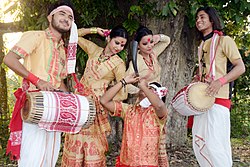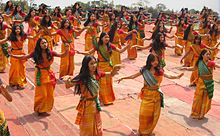Folk dances of Assam
| Part ofa serieson the |
| Culture of Assam |
|---|
 |
Folk dances ofAssaminclude theBihuand theBagurumba(both danced during festivals held in the spring), the Bhortal, theOjapalidance.Assamis home to many groups: Muslim, Indo-Aryan,Rabha,Bodo,Dimasa,Karbi,Mising,Sonowal Kacharis,Mishmi andTiwa (Lalung)etc. These cultures come together to create anAssamese culture.Residents of the state of Assam are known as "Axomiya" (Assamese). Most tribes have their own language, although Assamese is the primary language of the state.[4][5]
Many fairs and festivals are held in Assam. Nearly all tribal festivals are held in spring and celebrate cultivation or harvest. Among festivals in Assam, the Bihu is most noteworthy; it brings together all Assamese people, regardless of background.
Bihu dances[edit]
Although the origins ofBihu dance(Assamese:বিহু নৃত্য) are unknown, the first official record of it is said to be when the Ahom king Rudra Singha invited Bihu dancers to perform at theRang Gharfields in about 1694[4]for theRongali Bihu.[6]
Description[edit]
The Bihu is a group dance in which males and females dance together, but maintain separate gender roles. In general, females follow stricter line or circle formations. The male dancers and musicians enter the dancing area first, maintain their lines and follow synchronized patterns. When the female dancers enter, the male dancers break up their lines to mingle with the female dancers (who maintain their stricter formation and the order of the dance). It is usually characterized by specific postures: movements of the hips, arms and wrists; twirls, squats and bends. Male and female dance movements are very similar, with only subtle differences.

Performance[edit]
The dance is performed to traditional Bihu music. The most important musicians are the drummers (dhulia), who play a twin-faced drum (thedhol,which is hung from the neck) with one stick and a palm. There are usually more than onedhuliain a performance; each plays different rhythms at different sections of the performance. These rhythmic compositions, calledseus,are traditionally formal. Before entering the dancing area, the drummers play a short and brisk rhythm. Theseuis changed, and the drummers usually enter the dance area in line. Themohor xingor pepais played (usually at the beginning) by a single player, who lays out an initial plaintive motif which sets the mood for the dance. The male dancers then enter the area in formation and perform (accompanied by singing, in which all participate). Other instruments which accompany this dance are thetaal,a type of cymbal; thegogona,a reed-and-bamboo instrument; thetoka,abamboo clapperand thexutuli,a clay whistle. Bamboo flutes are also often used. The songs (bihu geet) accompanying the dance have been handed down for generations. Subjects of the lyrics include welcoming the Assamese new year, describing the life of a farmer, history and satire. Although males and females perform Bihu dance, the female Bihu dance has more variations (including freehand, twisting, with a rhythmicpepa,with akahi(traditional metal plate) and with ajaapi(Assamese conical woven hat). The performance may be long, but is enlivened by rapid changes in rhythm, mood, movements, pace and improvisation. Dancers and musicians are given opportunities to showcase their talents.
Types[edit]
The dance takes several forms in the different northeastern Indian groups (e.g. the Deori Bihu dance, Mising Bihu dance or Rati Bihu celebrated by Morans).[7]However, the underlying goal of the dance remains the same: to express the desire to feel both pain and happiness.
Bagurumba Dance[edit]

Bagurumbais a folk dance in Assam which is performed by theBodos.It is the usually practiced duringBwisagu,a Bodo festival in theVishuva Sankranti(mid-April).Bwisagubegins withcow worship;then, young people reverentially bow down to their parents and elders.
After that,Bathowis worshiped by offering the deity chicken andzou(rice beer). Bodo women wearing colourfuldokhnaandaronaiperform the Bagurumba dance (also known as the Bardwisikhla dance). It is accompanied by instruments such as theserja(a bowed instrument),sifung(flute),tharkha(split bamboo),khamormadal(long drum, made of wood and goatskin). The festival ends with a community prayer at Garjasali. This dance is performed in the Bodo-inhabited areas of Udalguri, Kokrajhar, Baksa, Chirang, Bongaigaon, Nalbari, Darrang and Sonitpur Districts.
Bhortal dance[edit]

Bhortal Nritya is known to have developed by Narahari Burha Bhakat. He was a well-known Satriya artist. This Bhortal Nritya of Barpeta district is said to have derived from the classical dance form of the state. This is one of the most popular dances in the state of Assam.
Performance— this dance is performed in a group. Six or seven dancers generally present the Bhortal dance of Assam together. This dance can be performed in larger groups as well. It is performed to a very fast beat. This beat is known as ‘Zhiya Nom’. The dancers are equipped with cymbals while performing this dance. The use of the cymbals makes the dance presentation appear very colorful. The dance movements are designed as such that they can produce some very colorful patters. This is the uniqueness of this dance from Assam.
Jhumur dance[edit]

Jhumuris a traditional dance form of "Adivasi" orTea tribescommunity of Assam. The dance is performed by young girls and boys together. The male members wear long traditional dresses and keep the rhythm with few traditional musical instruments, generally aDholor Mandar, hung on shoulders, a flute and a pair of "Taal" (two metallic discs). The girls mostly perform the dancing part, holding each other's waist and moving hands and legs forward and backward synchronously. The dance has a huge following in the "Tea tribe" dominated districts of Assam, likeUdalguri,Sonitpur,Golaghat,Jorhat,Sivasagar,DibrugarhandTinsukia.
References[edit]
- ^"639 Identifier Documentation:aho– ISO 639-3 ".SIL International (formerly known as the Summer Institute of Linguistics).SIL International.Retrieved29 June2019.
Ahom [aho]
- ^"Population by Religious Communities".Census India – 2001.Ministry of Home Affairs, Government of India.Retrieved1 July2019.
Census Data Finder/C Series/Population by Religious Communities
- ^"Population by religion community – 2011".Census of India, 2011.The Registrar General & Census Commissioner, India. Archived fromthe originalon 25 August 2015.
2011census/C-01/DDW00C-01 MDDS.XLS
- ^ab"Dances of Assam".Travelmasti.com.Retrieved24 August2012.
- ^Web.com(india) Pvt. Ltd. (18 February 2007)."Culture of Assam".Assam.gov.in. Archived fromthe originalon 28 November 2012.Retrieved24 August2012.
- ^"Bihu Folk Dances of Assam, Indian Folk Dances,Folk Dances of India".Indianfolkdances.com.Retrieved24 August2012.
- ^"Moran Bihu".AssamClicks.com.Retrieved29 March2016.
